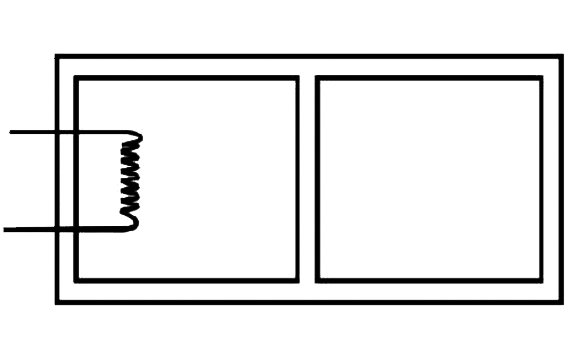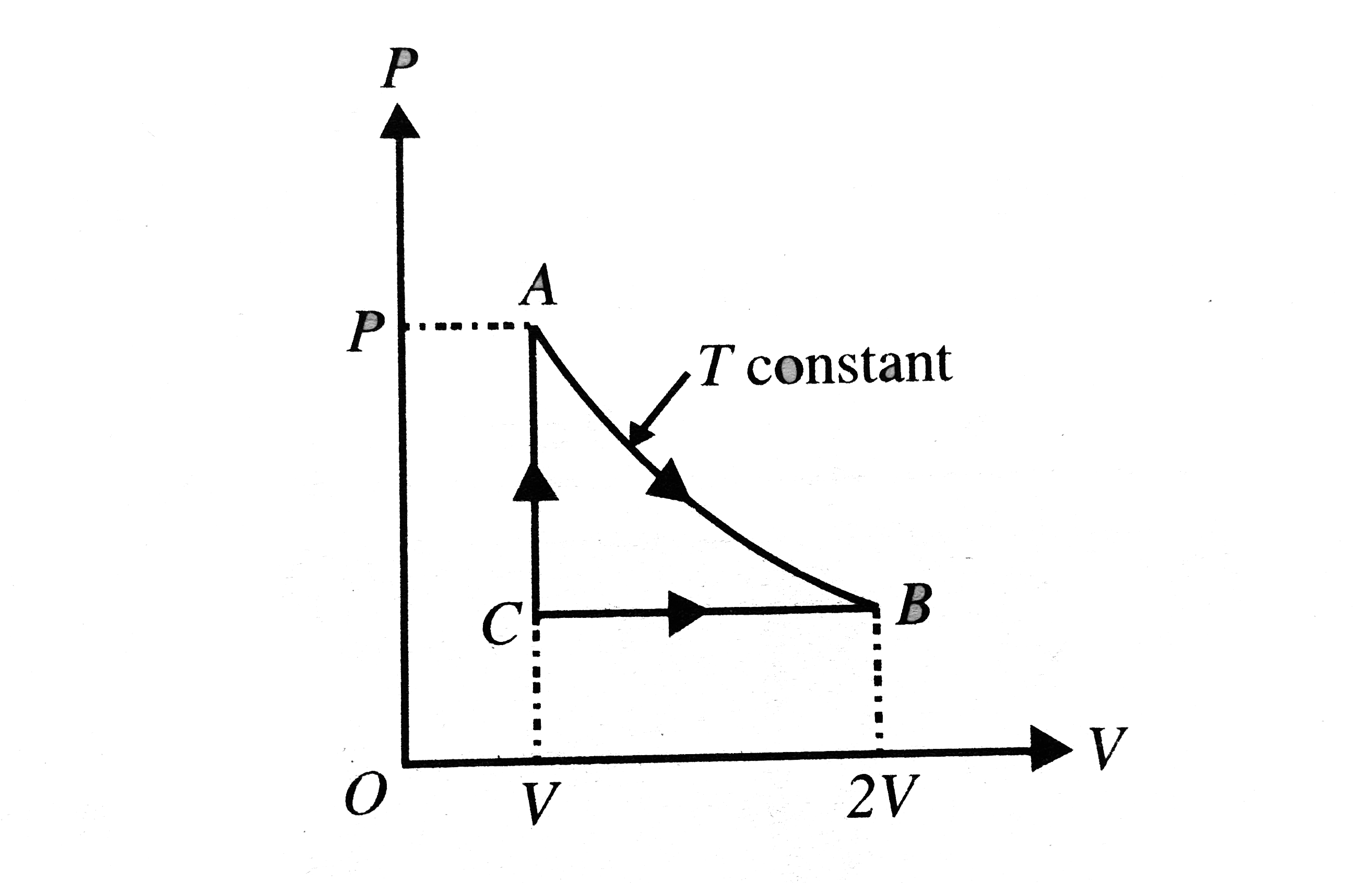Three moles of an ideal gas at a pressure PA and temperature TA is isothermally expanded to twice its initial volume. It is then compressed at constant pressure to its original , volume. Finally the gas is compressed at constant volume to its original pressure PA
(a) Sketch the P-V and P-T diagrams for the complete process.
(b) Calculate the net work done by the gas, and net heat supplied to the gas during the complete process.
The correct Answer is:(i) (##ALNPHYC07(I)E01273_A01##)(ii)workdo≠(ABCA)=0.58RT_(A),heat⊃plied(ABCA)=0.58RT_(A)
(iii) Work done by gas WAB=nR(TA)ln(VB)VA=3RTAln2
WBC=P02(V0−2V0)=−P0V02=−nRTA2=−32RTA
WCA=0
∴WABCA=RTA(3×0.693−15)=0.58RTA
∴ΔQABCA=WABCA=0.58RTA
_E01_273_S01.png)
Topper's Solved these Questions
- BOOK - ALLENCHAPTER - GEOMETRICAL OPTICSEXERCISE - EXERCISE - 04 (B)15videos
GEOMETRICAL OPTICS
- BOOK - ALLENCHAPTER - GEOMETRICAL OPTICSEXERCISE - EXERCISE - 05 (A)73videos
GEOMETRICAL OPTICS
- BOOK - ALLENCHAPTER - GEOMETRICAL OPTICSEXERCISE - Comprehension Based Questions66videos
GEOMETRICAL OPTICS
- BOOK - ALLENCHAPTER - CURRENT ELECTRICITYEXERCISE - EX.II66videos
CURRENT ELECTRICITY
- BOOK - ALLENCHAPTER - GRAVITATIONEXERCISE - EXERCISE 49videos
GRAVITATION
Similar Questions
The rectangular box shown in Fig has partition which can slide without friction along the length of the box. Initially each of the two chambers of the box has one mole of a mono-atomic ideal gas (λ=5/3) at a pressure P0, volume V0 and temperature T0. The chamber on the left is slowly heated by an electric heater. The walls of the box and the lead wires of the heater is negligible. The gas in the left chamber expands pushing the partition until the final pressure in both chambers becomes 243P0/32. Determine (i) the final temperature of the gas in each chamber.
 09:26View Solution
09:26View SolutionAn aluminium sphere of 20cm diameter is heated from 0∘C→100∘C. Its volume changes by (given that coefficient of linear expansion for aluminium αAI=23×10−5/∘C)
08:18View SolutionA certain amount of ice is supplied heat at a constant rate for 7 min. For the first one minute the temperature rises uniformly with time. Then it remains constant for the next 4 min and again the temperature rises at uniform rate for the last 2 min. Given Sice=0.5cal/g∘C,Lf=80cal/g.
The initial temperature of ice is02:28View SolutionIn the Bohr's model of hy drogen atom, the electron moves around the nucleus in a circular orbit of radius 5×10−11m. Its time period is 1.5×10−16s. The current associated with the electron motion is:-
04:19View SolutionAssertion : The difference in the value of acceleration due to gravity at pole and equator is proportional to square of angular velocity of earth.
Reason : the value of acceleration due to gravity is minimum at the equator and maximum at the pole.13:32View SolutionThree moles of an ideal gas (Cp=72R) at pressure, PA and temperature TA is isothermally expanded to twice its initial volume. It is then compressed at constant pressure to its original volume. Finally gas is compressed at constant volume to its original pressure PA.
(a) Sketch P-V and P-T diagrams for the complete process.
(b) Calculate the net work done by the gas, and net heat supplied to the gas during the complete process.02:00View SolutionThree moles of an ideal gas (Cp=72R) at pressure p0 and temperature T0 is isothermally expanded to twice its initial volume. It is then compressed at a constant pressure to its original volume.
(a) Sketch p-V and p-T diagram for complete process.
(b) Calculate net work done by the gas.
(c) Calculate net heat supplied to the gas during complete process.
(Write your answer in terms of gas constant =R)View SolutionOne mole of a gas is carried through the cycle shown in Fig. The gas expands at constant temperature T from volume V to 2V. It is them compressed to the initial volume at constant pressure and is finally brought back to its original state by heating at constant volume. Calculate the work done by the gas in complete cycle.
 15:16View Solution
15:16View SolutionOne mole of an ideal gas at pressure P0 and temperature T0 is expanded isothermally to twice ist volume and then compressed at constant pressure to (V0/2) and the gas is brought bac to original state by a process in which PαV (pressure is direclty proportional to volume). The correct temperature of the process is
View SolutionAn ideal gas intially has pressure P volume V and temperature T . Its is isothermally expanded to four times of its original volume, then it is compressed at constant pressure to attain its original volume V . Finally, the gas is heated at constant volume to get the original temperature T . (a) Draw V-T curve (b) Calculate the total work done by the gas in the process.(given ln2 = 0.693)
View SolutionA gas is suddenly compressed to one fourth of its original volume. What will be its final pressure, if its initial pressure is p
View SolutionThree moles of an ideal gas (Cp=7/2R) at pressure pA and temperature TA is isothermally expanded to twice its initial volume. It is then composed at constant pressure to its original volume. Finally the gas is compressed at constant volume to its original pressure pA (i) Sketch p−V and p−T diagrams for the complete process (b) Calculate the net work done by the gas and net heat supplied to the gas a during the complete process.
View Solutionएक 3 मोल आदर्श गैस (CP=72R) का दाब PA व ताप TA पर अपने प्रारम्भिक आयतन के दोगुने आयतन तक समतापी प्रसार होता है | तत्पश्चात यह नियत दाब पर अपने प्रारम्भिक आयतन तक संपीडित होती है | अन्त में, गैस नियत आयतन पर अपने प्रारम्भिक दाब तक संपीडित होती है |
(a) सम्पूर्ण प्रक्रम के लिए p-V तथा p-T आरेख खींचिए |
(b) सम्पूर्ण प्रक्रम के दौरान गैस द्वारा किया गया नेट कार्य तथा गैस को दी गई नेट ऊष्मा का परिकलन कीजिए |View SolutionThree moles of an ideal gas C_(p) = 7//2 R at pressure P_(A) and temperature T_(A) is isothermally expanded to twice its initial volume. It is then compressed at constant pressure to its original volume. Finally the gas is compressed at constant volume to the original pressure P_(A) .The correct P-V and P-T diagram indicating the process are
05:22View SolutionWhen a ideal gas with pressure P and volume V is compressed isothermally to one fourth of its volume, the pressure is P1. When the same gas is compressed polytropically according to the equation PV1.5 = constant to one fourth of its initial volume, the pressure is P2. THe ratio P1P2 is
08:16View SolutionThree moles of an ideal gas (CP=72R) at pressure P0 and temperature T0 is isothermally expanded to twice its initial volume. It is then compressed at a constant pressure to its original volume. a) Sketch P-V and P-T diagram for complete process b) Calculate net work done by the gas c) Calculate net heat supplied to the gas during complete process (Write your answer in terms of gas constant = R)
09:26View Solution

